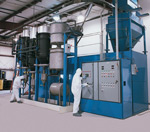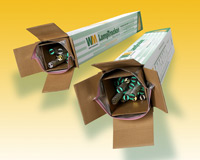
The Proper Package for Fluorescent Lamps
- By Brad Buscher, chair and CEO of VaporLok Products LLC
- Nov 19, 2009
The popularity of green is far more than a trend or an innate desire to protect waterways and wildlife. It is about what is practical. Rising energy costs and new policies have made waste unaffordable. But sometimes "green" products come with their own risks.
As a green product, fluorescent lamps are gaining popularity because they are
- four to six times more efficient,
- emit about the same amount of visible light,
- work longer, and
- save significant energy costs over incandescent lamps.
The rate of fluorescent use also is expected to increase when manufacturing of incandescent lamps (recognized by Congress as wasteful in 2007 energy legislation) winds down in 2013.
But as businesses embrace fluorescent technology, they must be aware that these lamps have to be disposed of properly. A broken compact fluorescent lamp (CFL) contains a small amount of mercury, but the U.S. Environmental Protection Agency provides guidelines for its disposal. One broken 48-inch fluorescent lamp in a small room or vehicle can release enough mercury vapor to exceed the federal Occupational Safety and Health Administration (OSHA) permissible exposure levels (PEL) of 0.1 mg/m3 (8-hr time-weighted average). To protect people and the environment from the risks of mercury vapor released by broken lamps, proper vapor-resistant packaging should be utilized. However, many packages marketed for fluorescent lamp transport do not provide the necessary levels of protection.
The Handling Risks
 Broken lamps also pose a significant occupational health risk to those involved in their storage, transport and disposal and a legal hazard for any businesses that do not adhere to agency stipulations. Burned out or broken, many states require that the lamps be recycled. EPA encourages lamp recycling by allowing common carrier shipment to recycling facilities, but the agency also says that packaging should be designed to protect against breakage. Federal laws, however, do not explicitly address mercury vapor release and packaging.
Broken lamps also pose a significant occupational health risk to those involved in their storage, transport and disposal and a legal hazard for any businesses that do not adhere to agency stipulations. Burned out or broken, many states require that the lamps be recycled. EPA encourages lamp recycling by allowing common carrier shipment to recycling facilities, but the agency also says that packaging should be designed to protect against breakage. Federal laws, however, do not explicitly address mercury vapor release and packaging.
Many business professionals and consumers think the benefits of fluorescent lamps far outweigh the risks, and the solution seems simple as recycling of many materials ─ paper and plastics to electronic devices — has been commonplace for years. But the very risks that make fluorescent lamp recycling crucial also make proper recycling difficult. Proper packaging not only protects against lamp breakage but also, in case breakage does occur, contains mercury vapor within acceptable levels, as determined by state and federal regulations. As a recent study found, not all current packaging options meet these requirements.
Package Protection
In a fluorescent lamp packaging study conducted by the University of Minnesota School of Public Health, Division of Environmental Health Sciences, results indicate that, if fluorescent lamps contained within various package designs broke, just one out of the five packaging configurations tested minimized mercury vapor enough to satisfy workplace exposure regulations.

Upon breaking, the fluorescent lamps released mercury vapor concentrations that could exceed PELs when personnel are working with or near broken lamps. This is an especially significant threat when multiple lamps are stored or shipped in bulk, as they are when sent to recycling facilities. So despite the best intentions of many recyclers, many lamps break during transit. These broken lamps can expose personnel to dangerous levels of mercury vapor.
In the study, four commercially available packages did not sufficiently minimize exposure levels. They were:
- a single cardboard box;
- a single box with a thin, unsealed plastic liner;
- a single box containing a thicker, tape-sealed plastic bag; and
- double box with a thicker, tape-sealed plastic bag.
When fluorescent lamps contained within the single cardboard box broke, mercury vapor concentrations in the test chamber were 10 times higher than the 0.1 mg/m
3 limit.
However, a double box featuring a patent-pending, proprietary vapor-resistant zip-closure bag placed between the two boxes reduced mercury vapor concentrations by 99.7 percent, making the exposure level well within OSHA and many stricter state exposure limits.
Recycling Rules Compliance
Fluorescent lamps typically are contained in bulk or in pre-paid shipping recycling boxes and transported to the recycling facility via truck.
The lamps are then crushed with the mercury vapor being safely exhausted and the resultant mercury extracted and reused. The remaining debris is then placed in 55-gallon drums and sent to a retort facility where they are heated to high temperatures to eliminate any remaining mercury. Resultant glass and aluminum can then be further recycled and reused.
The packaging concerns are problematic, but another alarming statistic is the number of fluorescent bulbs that are not being recycled. Despite the environmental, health and legal risks associated with lack of compliance, some consumers and businesses continue to discard fluorescent lamps improperly (see related story). EPA estimates that over 670 million mercury-containing lamps are discarded annually in the United States. That number is expected to increase as CFLs — more than 300 million are sold annually — grow in popularity among consumers.
Actual recycle rates are more difficult to gauge, because the rules governing their recycling and/or disposal do not provide for any tracking mechanism. In 2004, the Association of Lighting and Mercury Recyclers polled its membership in an attempt to estimate the total lamps recycled against EPA’s estimate of lamps discarded.
The membership at that time estimated a recycling rate of 20 to 25 percent, with the remaining percentage landfilled. Recycling volumes have grown annually, but not at the same rate of increased sales, when compact fluorescent lamps are factored into the volume. Without a mechanism for tracking the volume of lamps discarded, true recycling rates are unobtainable; therefore, it is impossible to know the risk of mercury vapor exposure.
With no universally enforced packaging standards to protect handlers of fluorescent lamps, manufacturers, transporters, retailers, consumers, and recyclers risk exposure to mercury vapor. Stricter regulations may follow but until then, the best practice is to be proactive. Recycling fluorescent lamps properly by using a proven packaging design to ensure the safety of those who may come into contact with fluorescent lamps — while still harnessing the energy- and cost-efficiency benefits this lighting provides.
Learn more about the regulations in your state, as well as other useful mercury related information, at http://www.vaporlokproducts.com/Regulations.htm.
Exemptions Hamper Mercury Recycling
Lamps that are not recycled typically are placed in dumpsters or trash containers and ultimately end up in landfills.
Federal policies contribute to this problem because they provide exemptions that help keep the recycling rate low. The Toxic Characteristic Leaching Procedure (TCLP) is a mercury test that allows lamps that pass the test to be exempt from recycling requirements. Lamp manufacturers have been able to pass this test by putting extraneous additives in the lamps, such as ascorbic acid, that compromise the test and therefore, skew test results.
In 2000, the Maine Legislature enacted a disposal ban on all mercury-added lamps following extensive debate focused on whether or not the ban should apply to lamps that pass the TCLP. New and used lamps from 10 popular lamp models were collected and tested for total mercury and TCLP mercury by specialized testing procedures. Results indicate that lamps that pass the TCLP test have similar total mercury results as their counterparts that fail TCLP. These results suggest that the disposal ban on all mercury-added lamps is appropriate.1 The scientific community knows the TCLP test is unreliable for lamps, but EPA has not yet changed the test.
Fluorescent lamps placed in dumpsters present a significant hazard. One study found that mercury is "strongly and persistently" emitted from dumpsters that contain broken fluorescent lamps.2 The data indicates an initial loss rate of ~25µg/h from just one bulb contained in a closed dumpster. The rate continued for more than a week, and was recorded at ~50 µg/h on the eighth day following breakage.
A significant volume of mercury-containing waste in the United States is also finding its way into Canadian landfills because there are no treatment standards or recovery requirements that compare to U.S. standards, which require that hazardous wastes be treated using “Best Demonstrated Available Technology” (high temperature retorting). Due to the high cost of retorting, the export of hazardous wastes to Canada is increasing. According to one report, if this increasingly popular trend isn't reversed, U.S.-based mercury recycling facilities will be undermined. Likewise, investments in the best available technology will be punished instead of rewarded.3 A uniform federal policy that prohibits land disposal would help eliminate confusion from the disparate state policies. Infrastructure and recycling capacity already exist, but as long as exemptions and low enforcement remain, and recycling remains optional, increasing the rate will continue to be a struggle. Suffice it to say, U.S. mercury recycling laws are in need of a major overhaul to protect the environment in the years to come.
1. Maine Fluorescent Lamp Study, DRAFT 1.0, November 15, 2001.
2. Lindberg, S.E.; Owens, J. PaMSWaD (Pathways of Mercury in Solid Waste Disposal); Lockheed Martin Energy Research Corporation (LMER). 1999. 6.
3. Fortuna, Richard C. Export of Recyclable Mercury Related Wastes to Canada for Landfilling and Barriers to Mercury Recycling in the U.S. Strategic Environmental Analysis, L.C. 2004. 3.
About the Author
Brad Buscher is chair and CEO of VaporLok Products LLC.